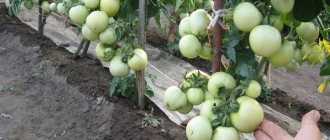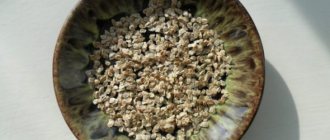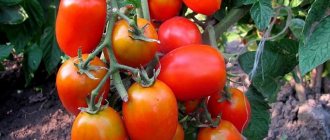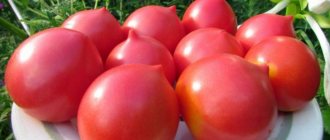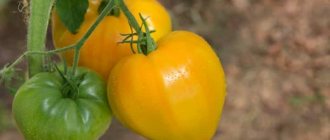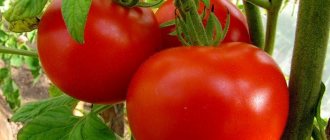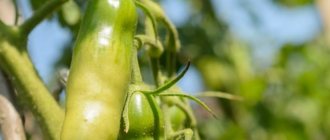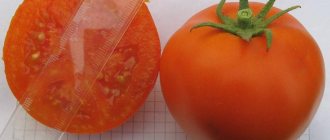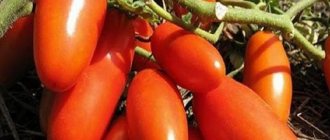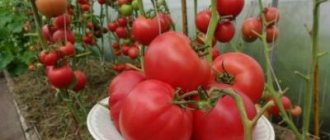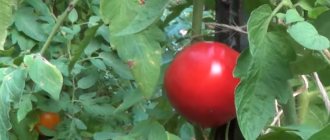The Pink Cheeks tomato appeared in seed stores recently, but has already become popular. Gardeners leave reviews about its stunning taste, which surprises even experienced tasters. The fruits are not only incredibly tasty, but also look impressive.
| Height | Landing location | Ripening time | Fruit color | Fruit size | Origin | Fruit shape |
| Medium height | Greenhouse | Mid-season | Pink | Large | Variety | Flat-round |
Description of the variety
The Pink Cheeks variety has managed to win the attention of many gardeners in a short time. It is mainly grown by summer residents of the southern regions of Russia, as well as their neighbors from neighboring countries. Tomatoes are best planted in greenhouse or greenhouse conditions. The plant loves fertile, nutritious and loose soil.
Distinctive features
The harvest ripens in 110-120 days from the moment of planting. For best results, it is recommended to use the seedling method. In open ground the bushes grow up to 90 cm, in greenhouse conditions up to 1.5 m.
The stem is powerful, the leaves are classic green. The Pink Cheeks variety has good immunity to disease and is easy to care for.
Characteristics of tomatoes and yield
Tomatoes are flat-round, pleasant red in color. The average weight of one vegetable is about 300 g, the structure is sugary and meaty. The taste is rich and juicy. 5-6 beautiful tomatoes ripen on one bunch. Tomatoes store well and withstand transportation.
The yield is stable; gardeners harvest about 6 kg of ripe vegetables from 1 sq.m.
Description of tomato Pink Spam
Gardeners who are interested in this hybrid should first of all know that it is not recommended for cultivation in all regions. Tomato shows its best qualities in the European part of the Russian Federation, including its north. And in the Urals and throughout Siberia, Pink Spam may not live up to expectations in terms of taste, yield, or disease resistance.
Tomato seeds Pink Spam from the author
In favorable weather conditions, Pink Spam is a vigorous, indeterminate plant. In a greenhouse, the main stem grows unlimitedly upward; in open ground it can end at a height of 1–1.5 m. Growth parameters depend on the presence of warm days; tomatoes stop developing at +15 °C.
The bush forms the first inflorescence above the 7–9 leaves, the subsequent ones, like any indet, after 3 leaves. Each cluster bears 7–9 fruits. The stalk does not have a dark green spot; the tomatoes are colored evenly crimson. It takes 99 days from germination to harvesting the first harvest, that is, it is an early ripening hybrid.
Pink spam sets up to 9 fruits in each cluster
The weight of the fruits is 160–190 g, they are smooth, heart-shaped. The manufacturer warns that depending on growing conditions, tomatoes may grow round. The skin is thin but durable, the flesh is dense. The harvest is well transported and stored. The tomato is resistant to cracking, but overripe fruits still burst.
Some gardeners manage to harvest tomatoes weighing more than 300 g from Pink Spam
The taste of the Pink Spam tomato, grown in suitable climatic conditions, is beyond praise. The pulp is juicy and fleshy, sweet, aromatic. There are 6 or more seed chambers, but they are small and there are no voids. Each square meter allocated for this hybrid will give you 25.6 kg of tomatoes. On average, one plant manages to ripen 5-6 bunches weighing 800-1000 g. The tomato is created for fresh consumption.
The State Register talks about resistance to fusarium, tobacco mosaic and cladosporiosis. Gardeners add that Pink Spam suffers from brown leaf spot and blossom end rot. But these shortcomings can be eliminated by proper agricultural technology and preventive spraying.
How to grow seedlings
Seedlings are a kind of guarantee of an excellent harvest. It is prepared 50 days before the plant is planted on the site. Let's take a closer look at how to prepare high-quality seedling material.
Seed preparation
To begin with, it is recommended to check the seeds for germination. Place the seeds in a container of water. Stir the liquid clockwise. Those seeds that sank to the bottom are suitable for seedlings, those that float are rejected.
Immediately after testing for germination, disinfect the material. Take a solution of potassium permanganate or aloe juice, soak the seeds in the liquid for 2 hours. Then take them out and dry them well.
Next, the seeds are germinated. Germination helps seeds quickly adapt to external conditions and develop lasting immunity to diseases. To do this, wrap the material in a damp cloth and place it in a dry and warm place. To accelerate growth, add growth stimulator “Zircon”. The product is sold at any gardening store. The main thing is to follow the dosage indicated on the package.
Container and soil
Use any clean container as a container. For example, plastic cups, boxes or boxes. Peat tablets or pots are especially popular among gardeners.
They are environmentally friendly, retain moisture, are easy to use and affordable. They are also easy to transplant the plant into the ground without harming the stem.
Ready-made “Universal” soil is perfect for seedlings. It is nutritious and fluffy, with the right level of acidity.
If desired, gardeners prepare the soil themselves, using soil from the garden, peat and sawdust. However, remember that such a mixture requires mandatory disinfection.
Sowing
Pour soil into a clean container and make holes 1 cm deep in it. Place seeds in them and sprinkle soil on top, then moisten the soil with warm water.
The distance between the holes should be at least 10 cm. For convenience, we recommend writing the name of the variety and the date of planting, especially if you are preparing seedlings of several varieties at once. Marking will prevent you from getting confused and planting tomatoes in the garden on time.
Growing and care
Seedlings are grown in the warmest and sunniest place in the house. Daylight hours for Pink Cheeks should be at least 8-10 hours. Water the seedlings every 7 days. Only warm water is suitable for irrigation.
Avoid using cold tap water . After 2 weeks, organize the first feeding. It is better to use liquid organic fertilizers.
Avoid drafts and air conditioning. The seedlings may catch a cold, which will have a bad effect on the future harvest.
Don't forget about hardening off the seedlings. It is carried out gradually: first, the containers are taken out onto the balcony for a couple of hours, and the time is increased every day, leaving the plant on the balcony longer and longer. It is recommended to harden off seedlings for the first time 2 weeks before planting in the ground.
Growing rules
Tomatoes require normal care and are propagated from seedlings. This is not a hybrid species, but an independent variety, so you can collect the seeds from tomatoes grown yourself or purchase them in a retail chain.
Planting seedlings
It is recommended to sow “Rosy Cheeks” tomato seeds for seedlings in the first half of March. Algorithm of actions:
- Prepare the soil (can be purchased at a specialty store): equal parts peat, humus or turf soil. Treat with a 5% solution of potassium permanganate.
- The container (container, peat or plastic cups) is filled with prepared soil.
- Tomato seeds are treated with manganese and placed in a growth-stimulating drug for 5 hours.
- Lay it to a depth of 1-2 cm, water it, and cover it with film on top.
The seedlings are placed in a warm place, protected from direct sunlight. After germination, the film is removed. When 3 leaves appear, they dive. The young tomato shoots remain in this state for 2 months. The seedlings are watered once a week and complex fertilizers are applied.
Tomato transplant
Tomato planting material is planted in a greenhouse for a permanent place of growth in early May, in open ground after the soil has warmed up to at least +130 C. The soil is first loosened, weeds are removed, and organic fertilizers are applied. Place tomatoes in 3 pieces. per 1 m3, maintaining a distance of 0.5 m between bushes and the same row spacing.
Subsequent care for tomatoes
After placing the “Rosy Cheeks” tomato variety, two feedings are carried out. The first is with phosphorus-containing agents before flowering, the second 2 weeks after fruit set. Recommendations for caring for tomatoes:
- Water as the soil dries out.
- All the stepchildren clean up.
- The bush is formed with a strong lateral shoot; you get two trunks: the main one is short, the auxiliary one is twice as long.
- As the growing season progresses, constant tying to the support is carried out.
In an open area, the soil is mulched with peat or straw; in a greenhouse this does not need to be done. Prevention of fungi and parasites is carried out.
How to grow tomatoes
For Rosy Cheeks, the ground has been prepared since autumn. Tomatoes love sunny and spacious areas. Dig up the beds using a spade and remove all debris and weeds.
When spring comes, dig up the area again and lay straw between the rows. It perfectly retains moisture and creates the most favorable conditions for the crop.
Landing
The distance between the grooves should be at least 50 cm. Place 1-2 seeds in one hole. Immediately moisten the soil with warm water. Organize the next watering only after 10 days. Experienced gardeners advise sprinkling the beds with peat crumbs.
Important! The best predecessors for tomatoes are legumes, onions and strawberries. It is not recommended to plant Pink Cheeks after other tomato varieties and potatoes.
Care
Remember to water your tomato beds every 7-10 days. The amount of moisture depends on the weather. On average, each bush takes about 0.5-1 liters. Use melt or rain water. It is more suitable for vegetables than others. Occasionally water the crop not with plain water, but with an ash solution. It strengthens the plant's immunity and protects against insect pests.
Tomatoes love nitrogen fertilizers and mineral supplements . They supply vegetables with calcium, phosphorus and iron, necessary for the normal development of bushes. Urea, the drug “Kornevin”, “Epin” are recognized as excellent remedies. The complexes are applied every 2 weeks, alternating with organic matter.
Important! Among organic fertilizers, the leaders are yeast, nettle, ash and potassium permanganate. Solutions based on them serve as an excellent remedy for late blight, septoria and other fungal infections.
Features of cultivation and possible difficulties
Summer residents pay special attention to weeding the beds and removing weeds. The measures protect the site from unwanted “guests” and also improve the soil microflora. The most common weeds found in beds with pink cheeks are bindweed, white pigweed, odorless chamomile and blackberry.
Remove weeds every week . Gardeners often resort to using herbicides. These are special chemicals designed to remove weeds.
Don't forget about loosening the beds. As a rule, the procedure is carried out after rains. Loosening improves the air layer of the soil and gives the roots access to oxygen. Often, loosening and weed removal are carried out simultaneously.
Diseases and pests
The most common and at the same time the most dangerous fungal disease of tomatoes is late blight. Appears as brown and yellow spots on the foliage. It is almost impossible to get rid of the disease, so we advise you to take preventive measures.
Spraying with a solution of potassium permanganate is recognized as an excellent remedy. An alternative option is a soap solution, for the preparation of which you will need 100 g of dry grated soap and 5 liters of water. The advantages of these products are that they are affordable and environmentally friendly.
The plant is also susceptible to infection with root rot. The reason lies in overly moist soil. The roots are covered with a black coating, due to which they soon wither.
To prevent this, gardeners recommend using the drug “Previkur” or “Tiovit”. Root rot is not as dangerous as late blight, but it can also destroy most of the crop.
Among the pests, the mole cricket attacks the beds, it attacks the roots and disrupts the plant’s metabolism. For preventive purposes, use dry eggshells, which you scatter on the garden bed. If the bushes are already sick, use the professional drug “Medvetox”. It is sold in granules, which is convenient to use.
Important! Also, Rosy Cheeks is occasionally attacked by whiteflies. This small white insect leaves mucus on the bushes, which harms the normal development of the bush. For preventative purposes, use a soap solution.
The nuances of growing in open ground and in a greenhouse
In a greenhouse, the variety produces more stepsons than in open ground. This is due to the fact that under cover the plant develops faster, reaching a height of about 1.5 m. Stepchildren are removed every 10 days. If the shoot is shorter than 5 cm, then for convenience, use scissors. If the bushes are not pruned in time, new ovaries form on the shoots, which will not be able to develop normally due to a lack of vitamins and minerals.
In open ground, pay special attention to the application of nitrogen-containing fertilizers. Their excess leads to cracking of tomatoes. Yellow spots also appear on the bushes, and the leaves begin to dry out. In this case, gardeners advise watering the beds abundantly and putting straw on them to remove “excess” nitrogen from the soil.
With improper care, there is a lack of potassium, as a result of which small leaves become dark and dry, curl and become wrinkled. The growth of fruits slows down, and the stepsons, on the contrary, begin to develop faster. To compensate for the lack of potassium, add potassium sulphide, ash or potassium magnesium to the soil.
Pest and disease control
If all care recommendations are followed, the tomato rarely gets sick. In greenhouses it is practically not damaged by pests. Common infections:
- Apex rot. Phosphorus-potassium fertilizers are applied and the root circle is covered with wood ash. For preventive purposes, tomatoes are sprayed with Bordeaux mixture before flowering.
- Late blight is eliminated with copper sulfate, “Hom”, “Fitosporin” by contact method. Walls and equipment are treated with a solution of lime and manganese.
- Root rot. Watering needs to be adjusted. The problem arises from waterlogging of the soil or mechanical damage to the root collar.
Weeding is recommended. For whiteflies of other insects, the preparation “Iskra Bio”, “Confidor”, “Commander” is used.
Harvesting and application
Pink cheeks are collected as they ripen in early August. Sometimes summer residents also pick dark green vegetables, which ripen already in room conditions.
Due to the dense peel, the variety is perfectly stored, especially if the tomatoes are placed in a moderately warm, dry place. Use wooden boxes or containers for storage.
Due to the high content of vitamins and minerals, the product is used for preparing dietary dishes. For example, these could be nutritious vegetable salads and lasagnas, as well as side dishes and cold appetizers. Tomatoes also make excellent sauces, ketchup and juice.
Even marmalade is made from tomatoes. In addition to tomatoes, oranges, citric acid, ginger, cinnamon and water are used to prepare it. This dish is stored in jars and will perfectly decorate your table at any time of the year.
Collecting seeds
If you liked the “Rosy Cheeks” variety of tomatoes, then you can further grow them from your own seeds. The collected seeds will have the same genetic makeup as their parent, and therefore the quality of the new tomatoes and their taste will remain just as great.
To collect seeds, the healthiest, most visually attractive, large tomatoes from the most fruit-bearing branch are selected.
The picked tomato should “ripen” on the windowsill. When it softens greatly, you can remove the seeds. The fruit is cut, the seeds are cleaned out along with the pulp. The seeds are thoroughly washed, draining the water 3-5 times until only the seeds remain in the container. Next, the seeds are dried, stirring regularly so that they dry on all sides.
Store the seeds in paper envelopes until the next planting. They are sown in the same way as purchased material. These seeds remain viable for 3-4 years. They grow into healthy, high-quality offspring.
Tip : poorly dried seeds will simply rot.
Advantages and disadvantages of the variety
The main advantage of the Pink Cheeks variety is its excellent taste and appetizing appearance. Tomatoes are good for fresh consumption and do not lose their benefits even after heat treatment. Vegetables are perfectly stored and transported and can ripen on their own. The variety also has excellent immunity and is not afraid of diseases and insect pests.
There are also disadvantages. The first is that the variety is demanding on growing conditions. In the northern regions of the country it is planted only in greenhouses. The second disadvantage is the mandatory stepsoning, which requires additional time and effort.
Transplanting seedlings into soil
Seedlings are planted in the ground with the onset of May. The deadline is early June. From the moment of emergence of seedlings, 60-65 days should pass. Wait until the last spring frost has passed. If you are going to plant a crop under temporary film, the most suitable time for this is May 15-25.
In order for the seedlings to take root and develop well, they are planted in areas of the garden where legumes previously grew: carrots, cabbage and potatoes. The most suitable soil is one that contains humus, compost, and superphosphate.
The soil is prepared in advance for planting. With the onset of warm days, as soon as the threat of frost has passed and the ground has warmed up, it is carefully dug up. Apply organic fertilizers (peat, compost, manure).
After digging holes for seedlings, minerals (wood ash, superphosphate, potassium and nitrogen fertilizers) are added there.
Proper soil preparation will help seedlings to easily take root and take root in a new place. The peculiarity lies in the method of planting seedlings. They are placed in the ground with a slight slope. This will help the tomatoes form additional roots on the stem that was buried when planting.
Similar varieties
Do not confuse the variety in question with the hybrid tomato Red cheeks f1. It ripens in 85 days, and the average size of one tomato is only about 100 g. From 1 sq. m summer residents receive about 9 kg of ripe and beautiful tomatoes. Due to its relatively compact size, the Red Cheeks F1 variety is excellent for whole canning, which cannot be said about the Pink Cheeks.
Another “relative” of the variety is Thick Cheeks. Ripens in 110 days, the bushes are compact, reaching a height of about 60 cm. The tomatoes themselves are medium in size, about 160-200 g. They are universal in use and have excellent taste. Thick cheeks are grown both in open ground and in greenhouses and greenhouses.
Recommendations and opinions of vegetable growers
Tomatoes Red cheeks F1, reviews of which indicate the high productivity of the variety, are popular among gardeners.
Evgeny Filimonov, 65 years old, Balashikha:
“I’ve been interested in growing tomatoes for many years, so I often experiment with different varieties, especially hybrids
I accidentally saw a photo of Red cheeks, which attracted attention with their flattened shape and bright coloring. I decided to try planting these tomatoes in open ground for the first time. I grew seedlings from the purchased seeds and planted them in the ground after the end of the spring frosts.
I mulched the soil, and periodically watered the plant and fed it with complex fertilizers. The result of the work pleased me with the harvest. The tomatoes are very juicy and delicate in taste"
I grew seedlings from the purchased seeds and planted them in the ground after the end of the spring frosts. I mulched the soil, and periodically watered the plant and fed it with complex fertilizers. The result of the work pleased me with the harvest. The tomatoes are very juicy and delicate in taste.”
Antonina Sheveleva, 47 years old, Podolsk:
“I grew the Red Cheeks variety in a greenhouse. I purchased the seeds from a company that guarantees quality. Before sowing, I soaked the seeds for some time in aloe juice in order to ensure a high percentage of germination. The formed bushes were transplanted into holes. Periodically loosened the soil near the bush. To prevent the stem from deforming under the weight of the tomato, I tied it to the pegs. Ripe tomatoes are as shown in the photo of the bag with seeds. Flattened shape, bright color and amazing taste.”
Farmer reviews
The Rosy Cheeks tomato is of interest to both gardeners from central Russia and farmers from colder regions. What do they say about these tomatoes?
Nikita, Chelyabinsk: “I plant the variety only in a greenhouse, and before that I always fertilize the soil. In general, I am pleased with the harvest, the return is friendly. The tomatoes turn out smooth and beautiful.”
Maria, Moscow: “Rosy cheeks are my favorite. I’ve been planting it for the third year in a row, I like the juicy and sweet taste. The variety is unpretentious in care, which I also like. I recommend everyone I know to try this tomato.”
Olga, Kirov: “I planted the variety for two years in a row. The first time the harvest came out good, I was pleased. But the second time the seedlings began to stretch out, and because of this they weakened. The yield was average and the taste was watery.”
Diseases and their prevention
Tomatoes Rosy cheeks are practically not susceptible to diseases. Only in rare cases can plants suffer from fusarium or late blight.
To prevent the harmful effects of pests on tomatoes, you should use an insecticide.
Reviews from gardeners about rosy cheeks
Lyudmila
Last time, on the advice of a friend, I planted a Rosy Cheeks tomato. I love growing new things. I really liked the variety due to its resistance to diseases and frost. I will plant more.
Angelina
This is not the first time I’ve grown Rosy Cheeks tomatoes. I really like their high yield, unsurpassed taste and rich pink color.
Larisa
I grow tomatoes for sale. I really like the Pink Cheeks variety.
It is not only very tasty, but also perfectly retains its shape during transportation, which is important for me as a seller.
Margarita Semyonovna
I bought several new varieties of tomatoes at the market. I liked the Rosy Cheeks tomatoes the most. Their juiciness, sweetness and chic appearance deserve the best praise.
Semyon
I bought a Rosy Cheeks tomato for the dacha. After the end of the season, I can note its high yield and extraordinary sweetness of the fruits. Next year I will definitely buy more seeds.
According to reviews from experienced gardeners, a stable, rich harvest can be noted. The most important thing is to ensure proper care, timely watering and loosening of the soil. The Pink Cheeks variety can be grown both for personal consumption and for sale.
“Rosy cheeks” - tomatoes that can charm the most demanding gardener
Hello, dear vegetable growers and tomato lovers!
Pink cheek tomatoes are new to my personal tomato collection. After all, as it happens... You go into gardening stores with seeds in winter, and your eyes widen at the display cases with all kinds of tomatoes.
It seems like I could plant everything: the descriptions of varieties and photos are so interesting and promising. And you will definitely buy something besides the prepared list of seeds. That’s what happened to me with “rosy cheeks” - they charmed me.
Some gardeners are afraid to buy unfamiliar varieties; they plant those that have been proven over the years. Yes, there is always a risk. If you read the promises of breeders, you will waste time and effort. It’s not always what you expect at the end of the season. But the “rosy cheeks” tomato will definitely thank you if you don’t deprive it of attention. And who knows, maybe this variety will be among your favorites?
Varietal features
I want to immediately disappoint the residents of the Urals and Siberia: do not waste time, as wonderful “rosy cheeks” will not grow on you. Breeders developed this variety only for a limited number of regions of Russia.
The Middle Volga region, the Center, the North-West, and the Middle Belt are advised to grow only in closed ground. In the Kuban and Caucasus, in the Crimea they do without greenhouses. Although agricultural technicians note: “rosy cheeks” tomatoes show themselves in full glory precisely under film or other cover. But even in garden beds under the sun and rain, gardeners in the southernmost territories are happy with the variety.
Caring for the variety after transplantation
For bushes of the variety, it is necessary to perform the correct garter and formation
Proper formation and careful tying to the support will allow you to grow a hefty harvest of tomatoes. To get the desired sowing result, you will need to adhere to the basic rules, namely:
- Schemes for planting bushes 40x50 cm. The density of plants should not exceed 4-5 pieces per square meter.
- Formation into one or two stems.
- Timely watering and fertilizing of plants. It is recommended to water with warm water. Feeding is carried out 3 times per season. In cases where the bushes grow greenery, but there are no flowers, you should feed the tomatoes using a phosphorus-potassium mixture.
- Careful stepsoning.
- Loosening the soil after watering.
Despite the heat-loving nature of Pink Cheeks, in extreme heat, tomatoes cannot set, or even shed existing ovaries.
In this case, it is advisable to use a solution of boric acid. It will not only help fruit set faster, but also prevent the appearance of late blight.
Spraying flowers and leaves with boric acid must be strictly observed in the ratio of 20 grams per 20 liters of water. Before mixing the acid, you need to dissolve it in a cup of hot water. The resulting mixture can be poured into a bucket and mixed. By spraying, you can see how the number of buds will grow.
A solution of boric acid will help the fruit set faster
Problems with growing plants can arise in cases where:
- the earth contains a large amount of fresh organic matter;
- the distance between the bushes is less than 45 cm;
- the landing site is in the shade;
- the soil is too wet;
- the soil is very dry.
Planting and care
Before sowing, the seeds are treated with potassium permanganate. This operation can reduce germination, so after 20 minutes in a manganese solution, the seeds should be rinsed well in running water. Then the seeds are sown in grooves made in a seedling box, which is filled with loose peat mixture.
Treatment with potassium permanganate protects against unpleasant diseases: blackleg, root rot.
When two leaves form on the sprouts, pick. This cannot be delayed. In a box, grown seedlings suffer from excessively humid air and may become covered with dark spots.
If the plants have managed to stretch out, when picking, they are buried deeper in the soil - up to the cotyledon leaves.
When growing seedlings it is important:
- carefully control soil moisture, avoiding waterlogging;
- keep the seedlings in the brightest possible place;
- if necessary, illuminate with phytolamps;
- a week before transplantation, start hardening - take it outside for several hours during the daytime.
The seedlings are planted in a bed filled with humus and superphosphate. Per square meter you will need half a bucket of organic matter and a glass of phosphorus fertilizers.
If tomato seedlings were grown in separate pots, then they will take root quickly - without wilting of leaves or stopping growth.
Overgrown seedlings can be planted obliquely, which will contribute to the formation of more powerful roots. As soon as the stems begin to grow, you need to install pegs or a trellis and tie them up. To secure the branches to the support, it is better to use synthetic twine.
Caring for the variety consists of watering and weeding. Stepchildren must be plucked off weekly, leaving only one that has grown under the first flower cluster. During the growing season, plants can be watered twice with a solution of potassium humate (two tablespoons per 10 liters of water). Potassium supplements improve the taste of tomatoes.
Recommended tomato varieties
San Marzano User rating: 4/5
Stick User rating: 5/5
Green Honey User rating: 5/5
Spring frosts User rating: 5/5
History of selection and regions of cultivation
Rosy Cheeks is a completely new variety, bred quite recently, in 2002, by Russian seed breeding scientists, and included in the State Register already in 2003. This type of tomato is suitable for cultivation both under film cover in temperate latitudes and openly in the south . Those who have already tried to grow Pink Cheeks are simply delighted with their incredible yield and unique resistance to almost all known diseases. The variety is recommended to grow:
- in the Central regions;
- in the Middle Volga;
- in the Volga-Vyatka region;
- in North-west;
- in the Black Earth Region;
- in the North Caucasus.
In addition to the Russian regions, Pink Cheeks have found their fans in Ukraine, Moldova, Belarus and Kazakhstan.
Pros and cons of tomatoes
The peculiarities of this type of tomato are that it does not have negative characteristics. That is, its cultivation will only be a plus for any person. But at the same time, it has many advantages:
- Large-fruited and early ripening.
- Very tasty, retains its presentation for a long time.
- Perfectly tolerates transportation over long distances.
- High yield volume.
- Tomatoes do not crack.
- Universal to use.
- Not susceptible to diseases.
- If you wish, you can collect the seeds and grow them yourself, since the tomatoes are varietal.
Characteristics of a tomato assume complete satisfaction with the resulting harvest
It is only important to fulfill all the necessary requirements and the result will please everyone
Advantages of a hybrid
The characteristics and description of the variety indicate the high productivity of the crop. As a first-generation hybrid, tomatoes cannot reproduce high-quality offspring for the next season. Therefore, it is recommended to purchase seeds in specialized stores.
A low-growing bush with a height of 100 cm has limited growth. During the growing season, 6-8 clusters with peduncles located on a strong stem are formed. The branched root system expands almost 1 m deep.
Tomatoes are resistant to late blight and tobacco mosaic virus. The plant is not affected by biological pests (mole cricket). The culture adapts well to temperature changes.
The universal growing method allows you to cultivate tomatoes in open ground and greenhouses. The tomato yield is 9 kg per 1 m².
Description of fruits:
- Tomatoes have excellent taste.
- The pulp of the fruit is juicy, tender, and sweet and sour in taste.
- Medium-sized tomatoes, weighing up to 100 g.
- Red cheek tomatoes have a round, flattened shape, a ribbed surface, and a thin glossy skin.
- Unripe fruits are pale green.
- At technical ripeness, tomatoes acquire a rich red color.
- When cut horizontally, 3-4 seed chambers with numerous seeds are observed.
- The dry matter content is below average.
In cooking, tomatoes are used for preparing salads, pickling, and marinades. They are used to produce tomato paste and juices.

